Functional evidence for a direct excitatory projection from the lateral habenula to the ventral tegmental area in the rat
- PMID: 27358317
- PMCID: PMC5013172
- DOI: 10.1152/jn.00305.2016
Functional evidence for a direct excitatory projection from the lateral habenula to the ventral tegmental area in the rat
Abstract
The lateral habenula, a phylogenetically conserved epithalamic structure, is activated by aversive stimuli and reward omission. Excitatory efferents from the lateral habenula predominately inhibit midbrain dopamine neuronal firing through a disynaptic, feedforward inhibitory mechanism involving the rostromedial tegmental nucleus. However, the lateral habenula also directly targets dopamine neurons within the ventral tegmental area, suggesting that opposing actions may result from increased lateral habenula activity. In the present study, we tested the effect of habenular efferent stimulation on dopamine and nondopamine neurons in the ventral tegmental area of Sprague-Dawley rats using a parasagittal brain slice preparation. Single pulse stimulation of the fasciculus retroflexus excited 48% of dopamine neurons and 51% of nondopamine neurons in the ventral tegmental area of rat pups. These proportions were not altered by excision of the rostromedial tegmental nucleus and were evident in both cortical- and striatal-projecting dopamine neurons. Glutamate receptor antagonists blocked this excitation, and fasciculus retroflexus stimulation elicited evoked excitatory postsynaptic potentials with a nearly constant onset latency, indicative of a monosynaptic, glutamatergic connection. Comparison of responses in rat pups and young adults showed no significant difference in the proportion of neurons excited by fasciculus retroflexus stimulation. Our data indicate that the well-known, indirect inhibitory effect of lateral habenula activation on midbrain dopamine neurons is complemented by a significant, direct excitatory effect. This pathway may contribute to the role of midbrain dopamine neurons in processing aversive stimuli and salience.
Keywords: brain slice; dopamine; lateral habenula; rostromedial tegmental nucleus; tail of the ventral tegmental area; tyrosine hydroxylase.
Copyright © 2016 the American Physiological Society.
Figures
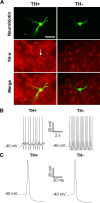


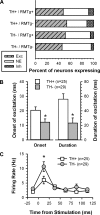


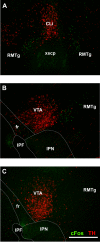
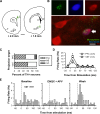
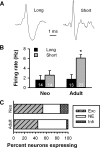

Similar articles
-
Lesions of the fasciculus retroflexus alter footshock-induced cFos expression in the mesopontine rostromedial tegmental area of rats.PLoS One. 2013 Apr 12;8(4):e60678. doi: 10.1371/journal.pone.0060678. Print 2013. PLoS One. 2013. PMID: 23593280 Free PMC article.
-
Glutamatergic Ventral Pallidal Neurons Modulate Activity of the Habenula-Tegmental Circuitry and Constrain Reward Seeking.Biol Psychiatry. 2018 Jun 15;83(12):1012-1023. doi: 10.1016/j.biopsych.2018.01.003. Epub 2018 Jan 12. Biol Psychiatry. 2018. PMID: 29452828 Free PMC article.
-
Lateral habenula stimulation inhibits rat midbrain dopamine neurons through a GABA(A) receptor-mediated mechanism.J Neurosci. 2007 Jun 27;27(26):6923-30. doi: 10.1523/JNEUROSCI.0958-07.2007. J Neurosci. 2007. PMID: 17596440 Free PMC article.
-
[Role of the lateral habenula and dopamine neurons in reward processing].Brain Nerve. 2009 Apr;61(4):389-96. Brain Nerve. 2009. PMID: 19378808 Review. Japanese.
-
The tail of the ventral tegmental area in behavioral processes and in the effect of psychostimulants and drugs of abuse.Prog Neuropsychopharmacol Biol Psychiatry. 2018 Jun 8;84(Pt A):30-38. doi: 10.1016/j.pnpbp.2018.02.002. Epub 2018 Feb 5. Prog Neuropsychopharmacol Biol Psychiatry. 2018. PMID: 29421265 Review.
Cited by
-
From controlled to compulsive drug-taking: The role of the habenula in addiction.Neurosci Biobehav Rev. 2019 Nov;106:102-111. doi: 10.1016/j.neubiorev.2018.06.018. Epub 2018 Jun 21. Neurosci Biobehav Rev. 2019. PMID: 29936111 Free PMC article. Review.
-
Does lateral habenula mediate effects of gestational stress on rat maternal behavior?Brain Behav Immun Integr. 2025 Jan;9:100098. doi: 10.1016/j.bbii.2024.100098. Epub 2024 Dec 11. Brain Behav Immun Integr. 2025. PMID: 40125261 Free PMC article.
-
Quantitative and qualitative sex difference in habenula-induced inhibition of midbrain dopamine neurons in the rat.Front Behav Neurosci. 2023 Nov 13;17:1289407. doi: 10.3389/fnbeh.2023.1289407. eCollection 2023. Front Behav Neurosci. 2023. PMID: 38025387 Free PMC article.
-
Functional Impairments in Learning and Signal Propagation Following Prenatal Kynurenine Treatment in Mice.Eur J Neurosci. 2025 Jul;62(1):e70185. doi: 10.1111/ejn.70185. Eur J Neurosci. 2025. PMID: 40640113 Free PMC article.
-
Association between habenula dysfunction and motivational symptoms in unmedicated major depressive disorder.Soc Cogn Affect Neurosci. 2017 Sep 1;12(9):1520-1533. doi: 10.1093/scan/nsx074. Soc Cogn Affect Neurosci. 2017. PMID: 28575424 Free PMC article.
References
-
- Aghajanian GK, Rasmussen K. Intracellular studies in the facial nucleus illustrating a simple new methd for obtaining viable motoneurons in adult rat brain slices. Synapse 3: 331–338, 1989. - PubMed
-
- Benabid AL, Jeaugey L. Cells of the rat lateral habenula respond to high-threshold somatosensory inputs. Neurosci Lett 96: 289–294, 1989. - PubMed
-
- Blanchard V, Raisman-Vozari R, Vyas S, Michel PP, Javoy-Agid F, Uhl G, Agid Y. Differential expression of tyrosine hydroxylase and membrane dopamine transporter genes in subpopulations of dopaminergic neurons of the rat mesencephalon. Brain Res Mol Brain Res 22: 29–38, 1994. - PubMed
-
- Brinschwitz K, Dittgen A, Madai VI, Lommel R, Geisler S, Veh RW. Glutamatergic axons from the lateral habenula mainly terminate on GABAergic neurons of the ventral midbrain. Neuroscience 168: 463–476, 2010. - PubMed
Publication types
MeSH terms
Substances
Grants and funding
LinkOut - more resources
Full Text Sources
Other Literature Sources

